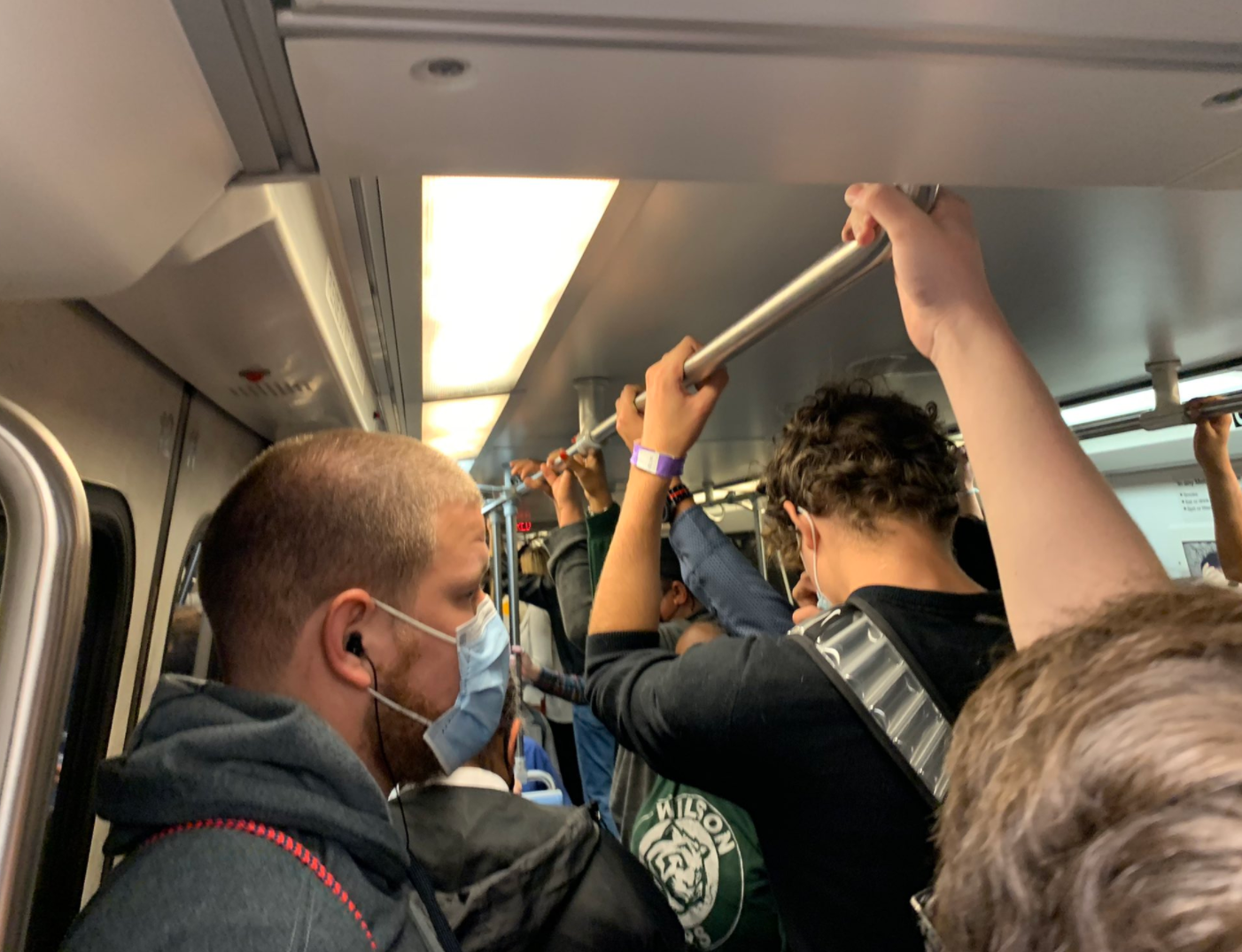
Metro said drastically reduced rail service will continue for the rest of the week as the investigation into last week’s Blue Line derailment continues.
Starting Tuesday and lasting at least until Sunday, Oct. 24, Metro said nearly all lines will continue to operate only every 30 minutes. The exception is the Red Line, where trains will operate every 15 minutes.
On the Silver Line, trains will operate between the Wiehle-Reston East and Federal Center SW stations only.
All trains will operate as six-car trains.
Metro’s announcement came the same day officials with the National Transportation Safety Board detailed their initial findings into the derailment, saying it appeared the train went off the track at least three times Oct. 12, including in a tunnel near the Rosslyn station, because the wheels on the train had shifted too far apart on their axles.
NTSB Chair Jennifer Homendy said a preliminary investigation found similar wheel problems going back to 2017 and that they appeared to have become more widespread recently, raising concerns the problem could affect other transit agencies across the U.S.
“We are fortunate that no fatalities or serious injuries occurred as a result of any of these derailments, but the potential for fatalities and serious injuries was significant,” Homendy said. “This could have resulted in a catastrophic event.”
Trains were crowded during the afternoon rush Monday on the Red Line, and passenger Erin Craig described people as being frustrated, while passenger Hector described his commute as “like a nightmare.”
Several passengers told WTOP reporter Mike Murillo, who reported from the Van Ness Metro station, that they are worried about crowded trains in the era of COVID-19.
One passenger told Murillo that she was not happy to hear that issues similar to what led to the train’s derailment had been reported in previous years; she feels Metro could have done more.
Late Sunday, the Washington Metrorail Safety Commission, which enforces safety practices on the D.C. subway system, ordered Metro to take all 7000 series rail cars out of service because of the defects uncovered in the rail cars’ wheel and axle assemblies, leading to bare-bones Metro service Monday morning, packed trains and massive delays for riders.
Metro said all 748 of its 7000-series rail cars — which are the transit system’s newest-model rail cars and make up 60% of Metro’s total fleet — remain sidelined and will not return to service until they are deemed safe to do so, which will significantly impact service.
Metro riders are encouraged to take Metrobus or consider other alternatives.
“Safety remains Metro’s number one priority,” said Metro General Manager Paul J. Wiedefeld in a statement Monday evening.
He added, “I want to assure our customers that their safety is driving every decision being made. We apologize for the reduced service, and ask for our customers’ continued patience and support as we work to get Metro back to normal operations. I want to thank Metro employees who are working around the clock. Your dedication is appreciated.”
The NTSB news conference earlier Monday provided more details about what turned to be a series of derailments on Oct. 12, all of the same rail car operating on Metro’s Blue Line.
The final derailment, at 4:51 p.m. that day, stranded nearly 200 passengers in a tunnel between Rosslyn and Arlington National Cemetery and sent one person to the hospital with non-life threatening injuries.
However, in addition to that derailment, NTSB investigators determined that Train 407 also derailed two times earlier that day.
At 3:23 p.m., Train 407 briefly derailed at Arlington National Cemetery before righting itself on the track, and again at 4:13 p.m. at Largo Town Center.
Investigator Joe Gordon, who’s leading the NTSB probe, said broken sections of brake parts at those two locations indicated the train had derailed, although it’s possible the train derailed elsewhere, too.
Repeated wheel failures since 2017
The suspected cause of the derailment is a defect in the wheel assemblies of the 7000 series rail cars.
As part of the investigation into the derailment, federal authorities were informed by Metro of similar problems with wheel assemblies dating back to 2017, and were told that they appear to have become more widespread in recent years.
In 2017, regular Metro inspections turned up two wheel failures, meaning the wheels shifted too far apart on the axles, Homendy said. There also were two failures reported in 2018.
In 2019 and 2020, there were four and five reported failures, respectively.
This year, however, the reported failures jumped to 18 — and that was before last week’s derailment.
In a round of emergency inspections that began Friday, Metro turned up 21 more failures, Homendy said.
“These are going up,” Homendy said of the wheel-axle failures.
And the numbers could still change: As of Monday morning, Metro had inspected 514 of its 748 7000 series rail cars, which are made by Kawasaki, the Japan-based manufacturer.
Asked whether WMATA took appropriate action to respond to the wheel problems going back to 2017, Homendy said, “That is exactly one of the questions we have in this investigation and something we will be looking at, because we do want to look at decision-making on WMATA’s part, what actions were taken and what led them to those actions — and whether they were sufficient.”
On its website, Metro said it had been working with Kawasaki since 2017 to resolve the wheel problem.
Homendy said the NTSB first learned of the wheel problems as a result of the current investigation.
The NTSB is concerned there could be similar problems with Kawasaki-made rail cars at transit systems across the U.S., Homendy said.
“If you’re a transit agency operating in the United States, and you’re listening, make sure that you’re checking your cars. … This is something we’re going to be looking at in the course of this investigation — to determine if there are more systemic issues throughout the U.S. and throughout transit systems operating in the U.S.” she said.
How long will 7000 series cars be sidelined?
It’s unclear how long the 7000 series cars will be sidelined. The safety commission’s order requires Metro to develop a plan to assess the cause of the wheel problems and find a way to detect and prevent the problem before returning the cars to service.
On its website, Metro said it would work with the safety commission to determine the “next best steps for returning the 7000 series to service.”
While the NTSB does not have the authority to order the 7000 series cars out of service, Homendy said the board supports the Metro safety commission taking action to do so.
“From a safety standpoint, we’re happy that they prioritized safety because, again, this could have been catastrophic,” Homendy said. “So, their focus here was public safety.”
Democratic Rep. Gerry Connolly of Virginia, a key backer of the bill creating the safety commission, called the decision to pull the rail cars “difficult but necessary” and demanded a plan from Metro for restoring service and rider confidence.
“According to the NTSB, WMATA did not take the necessary steps to address a potentially fatal mechanical failure of the 7000 series cars and let the problem languish and worsen over the course of four years,” Connolly said in a statement. “This is unacceptable and could have resulted in a catastrophic tragedy. I am demanding a plan of action from WMATA for how these issues will be addressed and rider confidence in system safety restored.”








